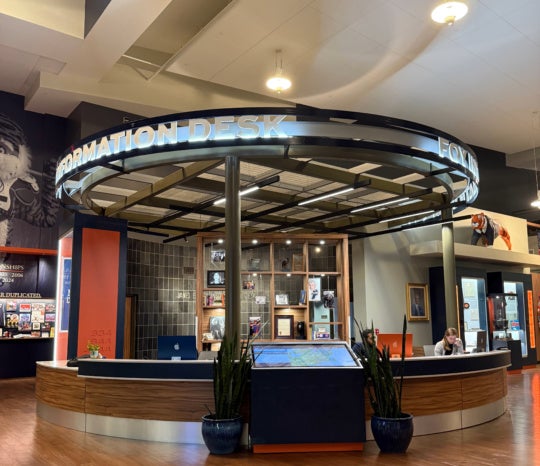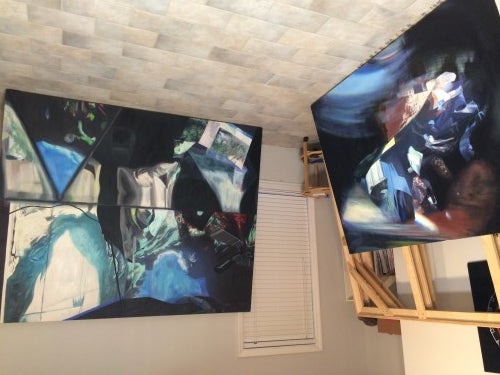
Ben Steele is an Atlanta-based painter whose works explore the imaginative construction of idealized places. Steele builds sculptures and installations in his studio and projects digital landscapes onto their surfaces, giving the images’ physicality in a complex space. Painting from photographs of these scenes, he attempts to capture the otherworldly appearance of these landscapes while drawing attention to their illusoriness. Steele received his MFA in 2008 from the Maryland Institute College of Art and has previously shown work in Baltimore and St. Louis. His solo show at {Poem 88}, “From This, A Mountain,” will be on view from April 26 to May 24.
Dan Weiskopf: These are visually complicated works. You might think that they would be planned out, but some people prefer to be more intuitive and let the work take shape in the process of making it. Where do you fall on this spectrum?
Ben Steele: That’s a really complicated question. When I am making the installations I have ideas, but I am always surprised. Usually what I thought was not going to be important ends up being the most interesting thing. But then when I’m in the painting stage, a composition is generally sound. However, I’m still doing a lot of refining. I’m not painting like a photorealist painter. I’m responding to what’s happening on the canvas—they are all hand drawn, hand painted, with many working layers that respond to the surface.
For example, here there are projected landscapes on the background and here pixels are becoming visible because the image is being blown up. That can be painted more in an Impressionist style to mimic the dissolving of the image. Or like where a little bit of blur is happening across the surface of the mirror where something has been reflected, this can be represented by streaking the paint. Within the same painting you can have this incredible graphic silhouette of an object, and it feels tangible. I feel like I’m really trying to get at these different states of image with paint. Ultimately, I think it’s one of the reasons why the work then becomes about painting, because I’m making the installations with that intent. I am consciously presenting images in ways that are about painting and the history of painting.
DW: Do you start with the object or with an idea of the installation?
BS: It’s gone both ways. Sometimes I start with the image that is being projected and sometimes I start with an object. If I construct something physically and project something onto it and then change the image, that introduces something unexpected and some great things have come from that. Another thing about the images: there is a real digital feel to them. I pull from both films and video games. I think of them as a shot into infinity, this idealized landscape. That’s in stark contrast to the shallow space that has been physically constructed.
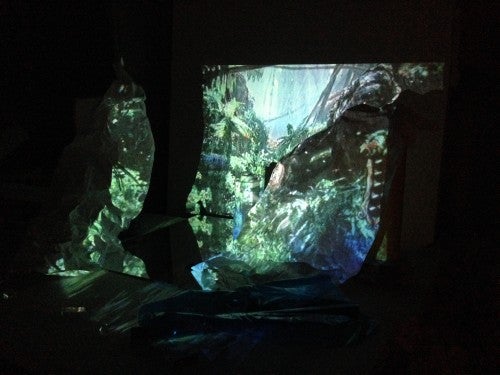
DW: Where are those images from?
BS: That one is from “Castlevania.” They’re all three-dimensional modeled environments. It’s a digital special effect being projected onto a physical object. I force them to interact through this process, because ultimately painting is a physical medium. The images are not of actual places in the world. They represent impossible scenes that only exist in our mind.
DW: I want to come back to this idea of infinity—I think this connects up with some things you’ve written about the sublime. I actually think these works are anti-sublime, but that’s a contestable concept. So, you start with an object that was made with an idea of how it might be viewed. Then you construct it, light it, photograph it—the sculptural part of the practice—and then from the photographs, you start the paintings themselves. The photographs are templates, fragments of the finished work. You’re not painting from the photographs directly, but you are assembling a bit from this one and a bit from that one to pull together an entire finished image. But you don’t think of this as kind of photorealism?
BS: No. A photorealist painter sees the image and tries to reproduce it. My interpretation of these photos is mediated through my own personal experience of building the still life. Despite the fact that it looks like an impossible, digitally altered scene, I know that the image was constructed as a projection, with this mirror here, and all that plays into what I’m trying to describe, which is the experience of seeing it.
DW: So what you get out of looking at the photograph is the experience of putting together the source and composing the shot and so on.
BS: Correct, as a basic compositional guide that has a hint of what I’m after in the final work. I read that James Welling considered his photographs to be documents of a performance. He often holds colored gels in front of the camera as he is photographing, as in his series “Glass House.” The photograph is a necessity in the process, playing that role of capturing something that’s really hard to see—transient.
DW: The images that you’re looking at are of things that are hard to see and hard to remember. Looking at these photographs, you see blur and streaking and distortions and stretching …
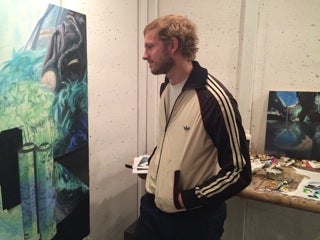
BS: That are all not photographic effects. They’re physically created effects.
DW: Exactly. The effect is created by interposing a prism, a piece of plastic, a gel or glass—something that is going to alter the light in physical space. The photographs help to fix the hard-to-see aspects of the physical installation itself, and they capture all the incidental details that work their way in there.
BS: They allow the things that I wasn’t focusing on to remain with me. I’ve really been excited by the idea that I can make an installation very quickly, crudely, and have it feel interesting when seen as an image and a painting. Something labored over for hours might not seem as interesting. That’s another way of balancing control versus chaos. I would never be able to do this in a painting, for example, but I could take three pieces of wood, break them, and throw them on a table, and that could be a form that could be interpreted as something in this scene.
DW: Do you think that gives you a way of improvising in physical space that you can’t achieve working in paint?
BS: I do. Ultimately, I want to be able to design like that. I’ve never been an artist working from my imagination in terms of just saying, “I’m going to decide to put this here.” Someone might say, well, if you want to put a red stripe in your painting, just do it. No. The way I do it is to go into my installation room, paint a huge red stripe, and then make that part of a scene so I can remind myself that it was initially on a surface in light and space before appearing on canvas. That’s how I would go about painting a red stripe.
DW: What kind of images do you use in this project?
BS: The unifying theme in my {Poem 88} show, which is called “From This, A Mountain,” is mountain imagery—generally speaking landscapes with clear slopes and a glimpse of sky, so you have this enclosed infinite space. So it’s about seeing the landscape and being pulled back into a larger space. At the same time you can recognize that this deep space is existing within a shallower space and is ultimately quite flat. I see this experience as quite like experiencing painting, which combines spatial illusion and surface. You’re painting on the surface and everything is an illusion. The projections play the role of image in the work, which ultimately is a physical surface. It’s almost like an accordion going in and out.

DW: Right, it’s what set theorists call an inverse mapping: a flat image gets projected onto a three-dimensional object, and then back onto a two-dimensional painted surface.
BS: You can sense what the landscape was, but it’s going through a translation. It’s coming out the other end irrevocably changed, having been projected and transformed three-dimensionally.
DW: Is that why you get passages where it looks like you’re experimenting with different styles, but they’re actually accidental?
BS: I would say part accident, like taking an image that’s pixelated through enlargement and painting it as an Impressionist would, or painting a blurred mirror reflection. All these are vehicles that allow me to paint in different ways in the same work. I would say that that aspect is becoming less accidental. I’m beginning to think more about how I would like to paint, therefore what I need to put into the installation. The installation and the materials I use are all means of achieving many languages of painting.
DW: If you didn’t know how your work was made, it might look arbitrary or contrived. All these styles are colliding in one frame. You might think this is kind of confusing, but it comes organically out of the process.
BS: It comes organically. My hope would be that it doesn’t feel arbitrary, because I went through this process of carefully figuring out what kinds of materials would be represented well by certain kinds of painting, and seeing through the process how much of a certain material the final composition could stand.
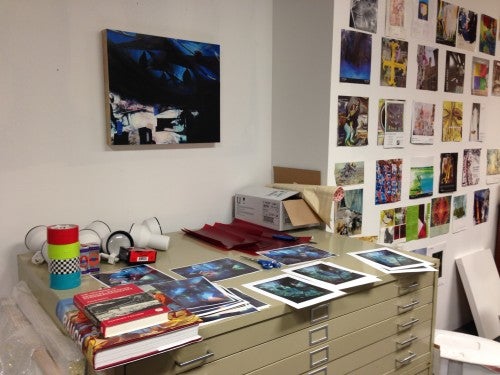
DW: Is there a significant art-historical influence on the stuff that you’re painting?
BS: Yeah, there’s the obvious ones like Monet. I’ve always loved his cathedrals, in particular. They almost look like a screen. Neo Rauch has also been a big influence. With him, there is a feeling of landscape as painted backdrop and he’s the one who made me realize that you could paint on the highest level and do shorthand for a landscape. Obviously, Gerhard Richter as well. He was probably my favorite artist in college. It was really thinking about how I’m attracted to the distortion of the image as a painter, and about how to make it about painting ultimately.
The first big leap into that understanding was in grad school. I was working from photographs and was spending a lot of time in my garden. I lived in a house with a huge garden, so my thesis ended up being scenes from that garden as seen through a prism. That was the epiphany: oh, I can paint landscapes, and I can paint from photographs if the landscape is interesting because it is distorted, and the distortion that I love isn’t coming from its being turned into a photograph. It all clicked.
DW: The New Leipzig School folks like Rauch and Matthias Weischer were in my mind as I was prepping for this. I saw in some of Rauch’s background echoes of the simplified landscape vocabulary and that seemed like a point of contact, but you don’t use figures. You’re just not interested in depicting people.
BS: In the very beginning I was doing photorealistic paintings of people in interesting lighting environments, like with high key colors. I was never satisfied with something I deliberately set up. I always preferred the thing that I just happened upon – then it was accidental but with intense control. Somebody in a critique once said, “I don’t think it’s about the person. It’s about everything else. The person is just there. It’s all about mood and light and atmosphere.” I took real personal offense. I went home for the summer, came back, and haven’t painted a person since.
I think the person was there because I didn’t know what my subject was, and that has been a huge struggle for me for ages. The landscapes have been a struggle because I knew I didn’t want to paint landscapes, but when you are after something totally intangible about perception while still being tied to representation, and you want it to feel abstract—it’s like, how do you get there without pulling stuff from your imagination?
DW: Is that when you got the idea that landscape as a subject could be interesting again? You can merge landscape with this technique of distorting or fragmenting the image, but not by just photographically manipulating the image. Was it an accident that you just had a prism lying around in the garden?
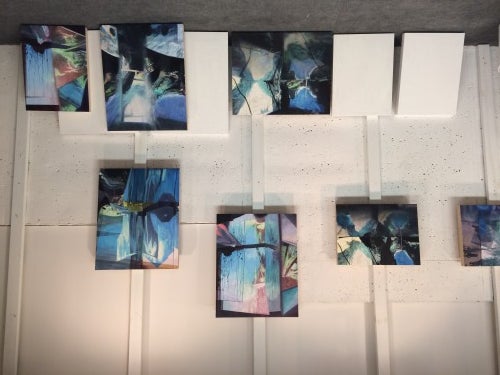
BS: This is a good question. One of my advisors recommended, that I get Goethe’s color theory book because I was into those flares and purple fringe that you see in photographs. He approached color as an artist not a scientist, and there is all this weird stuff in there that’s not scientifically accurate, but he did these experiments with prisms where the light would bend and you would see a black and white divide with the red and yellow on one side and the blue and purple on the other side. I was so fascinated by that, I thought: I need to see what he was talking about. So I ordered a prism. It had nothing to do with the work, but at that same time I was trying to find a way to abstract visions of nature and realized that that was the way to do it. The garden was the most controlled space, because there was a human element to it, but seen through the prism it looked like an infinite landscape. There has always been in my work the sense of a space that is shaped by a human: taking digitally constructed places that can’t exist in reality and forcing them to operate physically by projecting them onto actual matter.
DW: Gardens are always where things start! The garden is a tamed microcosm of the natural world that you happen to be in. Now you’ve gotten rid of the garden itself. This is kind of a story of the domestication of landscape painting. It’s the way to do landscape painting within a studio practice. I was interested in the way you see this relating to, for example, American landscape painting, which I know you’ve written about.
BS: Sure, the Hudson River Valley. I really like some of those paintings, the ones that are more light-based like [Frederic Edwin] Church or [Thomas] Cole. Ultimately, that’s not my favorite kind of work—I like Monet more. I gained an appreciation for it when I was exploring these ideas of the sublime. You called it anti-sublime, which may be true. I would argue that the anti-sublime is also the sublime, in that I feel like there has to be some recognition among contemporary artists that you can’t just paint the sunset. What are you building into it? For me, it’s awareness of human perception. Making somebody aware that I’m looking at a painting and this is an image, but it’s an image within a space on a surface. That’s a result of human perception. That’s how I think my work operates in the sense of the sublime. These powerful spaces are out there, but our perception of them is essentially what creates them.
DW: One way of thinking about the whole tradition of the sublime is that it’s about our perceptual confrontation with things in the world that are terrifying, if you’re [Edmund] Burke, or just infinite and overflowing, in the case of Kant. These are different ideas. You’re either bowled over and crushed under it or you resist it and master it. Either way, it’s something that imposes itself on you perceptually that you can’t deal with. So when people are painting the sublime, they are trying to give you a confrontation with something overwhelming or overflowing. The reason I thought these are anti-sublime is because you are trying to confront people with something about perceptual experience, but the experience doesn’t have the unity that Burke would’ve demanded. It’s kind of fractured or dissolved, or there are multiple sets of perspectives, and that’s something that traditional theories of the sublime wouldn’t have recognized. The way in which space is fractured and objects dissolve and surfaces drift in space seems like the disintegration of the sublime landscape.
BS: I think in that old sense you’re right. These works are about the sublime, but not sublime themselves. They have the sublime noted as an element.
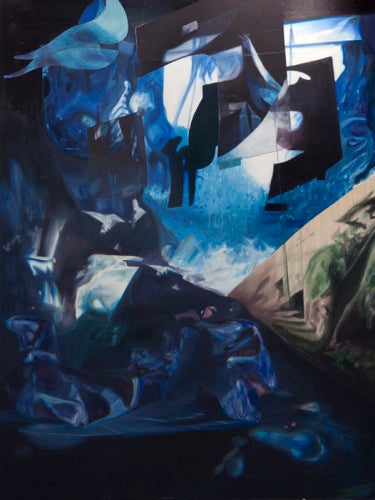
DW: I like the simple image of the garden and the prism as the starting point of all this. Did you use photography then?
BS: Yeah, it’s the same thing. The effects that were most interesting to me were fleeting and almost impossible to achieve twice, and something has remained of that. As for why it has become more complicated, I think the prism became … everything I was painting, I was painting through glass. I was getting really tired of the limiting format of these horizontal bars from the prism and I felt like I didn’t want to have to look through something to achieve the effect I want. How can I start to make that happen in the thing itself? I love the idea of it becoming more like a stage set, and beginning to utilize tricks from visual effects cinematography like rear projection, matt mirrors, and scale models. And now there is an element of control, but there is also a lack of control in terms of physical reality and the construction of it.
DW: It’s that balance of control and improvisation that makes it so different from the natural world, where you have to take what it gives you.
BS: Absolutely. It’s my controlling self coming in. I think in the materials and process that I’m using, there are many possibilities for me to still be surprised. Another reason is the red stripe example. Now I have the ability to make a painted mark a part of the vocabulary. And it no longer just is itself—it represents itself in the space. And that idea to me is really powerful.
Dan Weiskopf is an associate professor of philosophy and an associate faculty member in the Neuroscience Institute at Georgia StateUniversity. He is the author, with Fred Adams, of An Introduction to the Philosophy of Psychology, forthcoming from Cambridge University Press.



